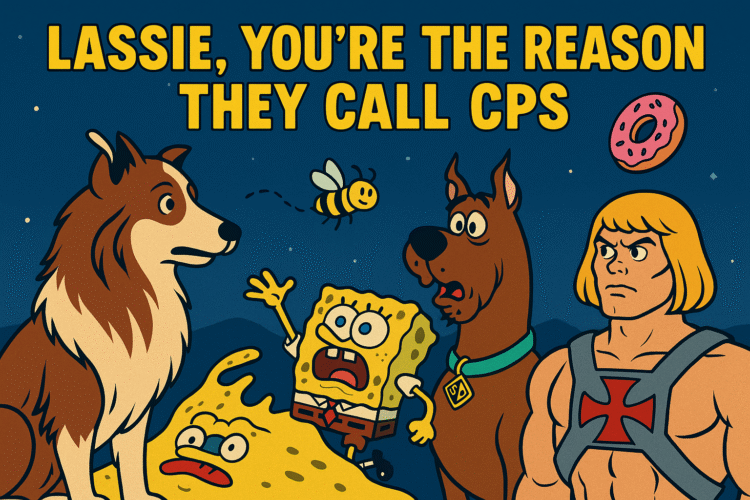
Look, I’m not saying Lassie is a sociopath. But I’m also not not saying it. For years, the beloved collie has been hailed as the paragon of loyalty, intelligence, and tail-wagging heroism. Every week, she was dragging her shaggy little boots across farmland and throwing dramatic looks toward camera operators in a silent plea to rescue her human, Timmy, from yet another well.
But let’s be honest: at a certain point, Timmy wasn’t falling into the well. Lassie was pushing him.
I’m not even kidding. Hear me out.
There’s no recorded veterinary science that can prove a dog knew how to detect both location and depth of a human child’s body in a 40-foot well, while also intuitively knowing to run five miles through fields, knock on Farmer Johnson’s door with her paw, and bark in Morse code. It’s much more likely that Lassie was suffering from what I like to call “Savior Complex Syndrome.” That’s right. Lassie needed to be needed. So she created the danger.
Timmy was just the first victim.
Let’s dig into the shady archives of our favorite classic characters, shall we?
Scooby-Doo and Shaggy: High on Snacks and Paranoia
These two were not solving mysteries—they were manufacturing them. You mean to tell me that every haunted amusement park was actually just a misunderstood janitor in a latex mask? Every time? At some point, Occam’s Razor says Scoob and the gang were just profiling low-income workers with seasonal depression. Velma always had a plan, Fred had unearned leadership energy, Daphne was duct-taped into a plot device, and Scooby and Shaggy? Full-on liability with the munchies.
Also, where were their parents?
Garfield: A Manifesto of Toxic Laziness
Ah yes, the feline face of apathy. Garfield didn’t just hate Mondays—he hated effort, accountability, and any form of emotional vulnerability. This is a cat who gaslit Jon for sport, verbally abused Odie (a literal sweetheart), and binged lasagna like it was a coping mechanism for unresolved trauma.
Which—relatable. But still.
What’s wild is that generations of children looked at Garfield and thought, “Yes, this is the kind of jaded nihilism I aspire to by age eight.” We were doomed from the start.
Barney: Love Bombing and Coercive Friendship
Barney the Dinosaur didn’t love you. He told you he did. Constantly. Loudly. In a catchy song designed to overwrite your brain like spyware.
Think about it—he appears, sings “I love you, you love me,” and suddenly you’re trapped in a purple cult of felt and forced affirmation. That’s not friendship. That’s emotional manipulation. I’m not saying Barney should’ve been investigated by the CDC, but I’m also not saying he shouldn’t have been.
The Road Runner: Actually Kind of a Dick
You ever notice how the Road Runner never shows fear? Not even once? That’s not bravery—that’s sociopathy. Wile E. Coyote, a small-business innovator just trying to eat a meal in a barren desert, ordered thousands of dollars of equipment from ACME just to feed himself. He wasn’t chasing the Road Runner for sport—he was literally starving.
And what did the Road Runner do? Smirk. Taunt. Mock his efforts. Not once did he offer to split a granola bar. No empathy. Just trauma loops.
Popeye: One Spinach High Away From a Lawsuit
If Popeye aired today, he’d be labeled a cautionary tale about substance abuse and rage. That man did not handle conflict—he escalated it by eating performance-enhancing greens and throwing hands. Olive Oyl was constantly being kidnapped because apparently no one ever thought to teach her a basic self-defense course. Bluto had obvious impulse control issues, and Popeye, rather than calling a social worker or de-escalating, just got swole and treated the docks like a UFC ring.
Clifford the Big Red Dog: Gentrification in Canine Form
Let’s talk about what happens when your dog grows to the size of a mid-tier skyscraper: property damage, constant lawsuits, FEMA involvement. Clifford wasn’t a pet—he was a zoning violation with paws. You know how much it costs to build new infrastructure to accommodate a 200-foot dog? Emily Elizabeth’s family single-handedly destroyed their housing market.
And yet somehow, Clifford is the hero? The only thing redder than his fur was the ink on the town’s bankruptcy documents.
The Berenstain Bears: Performative Parenting with Toxic Positivity
These bears were always learning a lesson about things like “manners,” “chores,” or “sharing.” But did anyone ever check in on Papa Bear? He clearly had undiagnosed ADHD, explosive DIY energy, and a wife who was two seconds from leaving it all behind. The books weren’t about moral clarity—they were thinly-veiled family therapy sessions. We were watching them unravel in real-time.
Caillou: Birth Control for an Entire Generation
You know I had to go here.
Caillou was the poster child for tantrums and emotional terrorism. Every episode was a new reason to mute the TV, take a deep breath, and consider getting a vasectomy. Even his theme song was annoying. He whined his way through life like he was entitled to air and snacks just for existing—which, okay, same, but at least I’m not broadcasting it to toddlers.
Conclusion: Trust No Cartoon
In short, don’t trust nostalgia. Your faves were problematic. Lassie was shoving Timmy into that well for attention. Scooby-Doo was hallucinating crimes. Garfield needed a therapist and some iron supplements. And Barney? Barney loved you way too much, too fast.
If you learned anything from this, it’s that childhood media was just a long con to normalize chaos, teach us that weird behavior was “quirky,” and prepare us for adult life where the real villains are probably wearing a mask from Party City.
Also, someone please check on Timmy. He’s still down there, probably. Waiting.